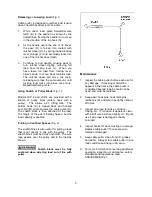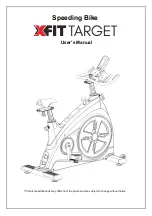
5
Releasing or Lowering Load
(Fig. 1)
Cable puller is designed to ratchet load tension
down one ratchet wheel tooth at a time:
1. While under load, place forward/reverse
latch (B) to the position as shown by the
dotted lines, freeing the handle (A) to move
in the direction of the top hook (N).
2.
As the handle nears the end of its travel,
the pawl (D) is forced into contact with
ratchet wheel (H), by spring loaded locking
lever plunger (F) and eventually locks into
one of the ratchet wheel teeth.
3. Continue to pull handle, causing pawl to
turn ratchet wheel slightly, relieving full
load from locking lever (J). When you
have taken full load from locking lever,
allow handle to move back towards load.
The ratchet wheel will move one tooth,
releasing wire rope the same amount, until
locking lever locks into place once more.
Repeat ratcheting cycle.
Using Snatch or Pulley Block
(Fig. 1
)
Models JCP-2 and JCP-4 are provided with a
snatch or pulley block (safety hook with a
pulley). This allows a 2:1 lifting ratio. The
bottom hook (K) is looped back and hooked
over bolt (M) which secures the cable guide (O).
The snatch block is then attached to the load.
The length of the pull is thereby halved, but the
load capacity is doubled.
Pulling in Confined Spaces
(Fig. 2)
The snatch block is also useful for pulling a load
that is not directly in line with the puller. The
snatch block must be firmly anchored. The wire
rope passes over the pulley and to the load as
shown.
Snatch block must be fully
anchored when winching load out of line with
puller.
Maintenance
1. Inspect the cable puller before each use for
any damage. If cracking or distortion
appears in the frame, the cable puller is
considered beyond repair, should not be
used, and must be replaced.
2. Keep pawl, hook pins, hook latch pins,
ratchet pivots, and wire rope lightly oiled at
all times.
3. Inspect wire rope for kinks, corrosion,
fraying, etc. If corrosion is apparent, clean
with a stiff wire brush and lightly oil. Do not
use if wire rope is damaged or badly
corroded.
4. Inspect hooks for wear, twisting or damage.
Replace cable puller if hooks are worn,
twisted or damaged.
5. Keep cable puller clean from dirt, grease
and water. Always store cable puller in a no
load condition and hang in dry area.
6. For more information concerning additional
operation, inspection, maintenance, safety
standards and regulations, read
ANSI/ASME B30.21.


























